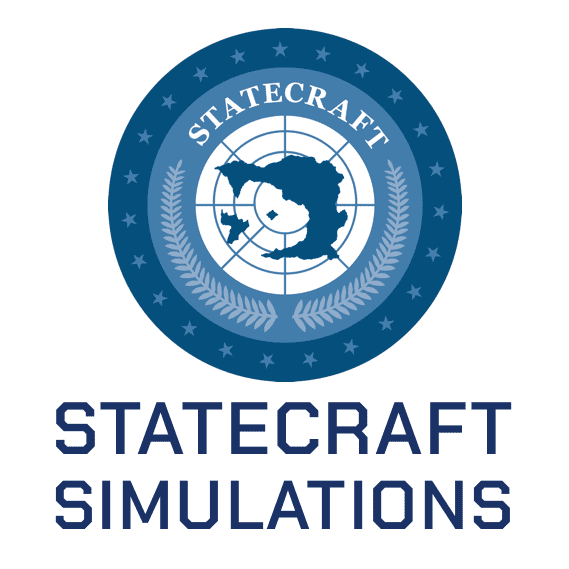Introduction to Political Science Simulation
for Understanding the Political World
Students spend 3 weeks in the Gov Lite simulation and 5 weeks in the IR Lite simulation. They build countries from the ground up by selecting and analyzing contemporary government and economic types. They’ll draw connections between the different political philosophies associated with each one and plot their foreign policies. Students will play US government roles in the executive, legislative, and judiciary while spending each week building, executing, and experiencing the benefits and consequences of government policies ending in midterm elections.The Introduction to Political Science Bundle costs $39.75 per student and requires support setup. Contact [email protected] for help.
Length of Simulation & Class Time
The IR Lite and Gov Lite bundle allow you tremendous flexibility to schedule your simulations at different points of the semester. Start Gov Lite during the American Politics portion of your syllabus for 3 weeks and start IR Lite when you cover comparative politics and foreign policy for 5 weeks.
Note: A rule of thumb when scheduling turns or periods is that each one requires about 1.5 to 3 hours of work from the students.
Turn/Period 0 is a Tutorial week for students to establish a basic understanding of the simulation to decide on their government system and explore their roles in American government. The sim runs live 24/7 which allows for maximum convenience for both instructors and students to cut deals and make decisions on their own time. We recommend establishing a 7 day per Turn or Period schedule and having at least one day per week where you encourage students to negotiate, hold negotiations, and even make speeches defending their actions on various global and domestic issues.
Alternative Schedule Formats
One day sim: If you want to run the simulation in one day you only need 30 minutes between turns. In a format like this you would schedule an all day play through with students on a saturday or sunday from 8 AM to 5 PM with a lunch break. It is recommended to contact support at [email protected] for assistance and guidance on this setup
What Happens During a Turn
The simulation automatically groups students into roles or countries based on an attitude survey they take during the signup process. During the setup turn students choose their government and politics system in the IR Lite SIm. For the Gov Sim they learn about their role in the Executive, Legislative, and Judicial Branches along with the Media.
Every week students are given a checklist and walkthroughs of their screen to guide them in achieving their goals and interacting with each other. At the beginning of each Turn, students receive news messages with updates on major events and situations unfolding in their simulation. Instructors can also find these under “News” on the top of the instructor dashboard.
From here they will start making decisions about trade, country development, domestic politics, economics, the environment, and national security. All of their choices are cancellable until the turn ends. Once the turn ends the simulation will calculate the impact of all student choices and start the next turn with new world conditions and unfolding sim events.
Suggested Base Knowledge of Students
No base knowledge is required, however, to maximize the learning experience for students, we recommend the simulation start after covering the basics of the course for at least a few weeks.
Class Assignments
Many instructors get creative with how they connect classroom assignments to the simulation. These may be a good fit for your class:
- Memos: Instructors can provide students with a list of memo prompts that help students tie their simulation experience to course topics.
- Debrief Presentation: This is a guided debrief that helps students reflect on the key moments that unfolded throughout the simulation. This allows them to “reveal their cards” and openly explain their perspectives and actions from a 360 degree perspective. It is a great opportunity to encourage students to use their memos as historical references in creating a comprehensive presentation that they give to the rest of the class. Some classes have formalized this presentation and made it public to a larger audience.
- Debrief Paper Assignments: A paper to go along with the Debriefing Presentation that goes more in depth on how the debrief topic unfolded during the simulation.
Student Engagement Tracking
To keep track of students decisions, there are multiple tools for instructors to utilize:
- The toggle option at top left of the map gives instructors a visual display of countries’ international attitudes and actions involving trade, diplomacy, conflict, and country development. The map is populated with country development rings surrounding capital cities along with colored arrows that indicate an array of collaborative and aggressive actions. Instructors can click on them to “drill down” for specific details about each action and country interaction.
- Weekly emails go straight to the instructor inbox and give an overview of sim events, country attitudes and general actions, and a students’ engagement report.
- Reading at least one memo from each country during each week can be a great way to understand how students perceive what is happening and how they currently feel about other countries and simulation events. You can even change the memo topic for each week based on the things you would like to better understand from the student perspective
- Instructors can also log into each students’ dashboard and read their messages to see which peers a student may be interacting with.
Grading
The following grading criteria is a basic recommendation and can be customized to fit your classroom needs.
- 5% – Simulation Performance: Students’ simulation performance score is based on the accumulation of points through the achievement of collective goals, competitive goals, and the best average Quality of Life scores.
- 5% – Role Research Assignment: Students research the roles and submit an assignment that include their role including description, duties, why they are interested in each role, and a historical example
- 10% – Simulation Participation: Students are prompted to take two Manual quizzes during Turn 0 and Turn 1 which can be used as part of the participation grade. Students can connect the course materials more meaningfully to their class by writing weekly memos. Students are also prompted to rate the level of influence of exceptional peers in the simulation. You can add this Sim Participation, Sim Performance, or consider giving it as extra credit for anyone who receives it.
- 15% to 30% – Paper or Debriefing Presentation: The paper or debriefing presentation requires you to integrate your simulation experience with a variety of course concepts.
- 10% – 25% – Debriefing Paper – a paper that accompanies the debriefing presentation over the same topic. Students turn in their paper after they debrief the class on their chosen topic.
Enhance your introduction to Political Science Learning with Statecraft's IR and US Gov Lite Sims: A Practical, Interactive Complement to Leading Textbooks on Global Organizations and U.S. Government Dynamics, Enabling Students to Experience Real-World Diplomatic and Policy-Making Scenarios
“International Organizations Fourth Edition” by Ian Hurd: This textbook focuses on the legal and political dynamics of international organizations. The IR Lite sim allows students to engage directly with these dynamics, simulating international negotiations and legal frameworks, while the US Gov Lite sim provides insights into how national policies influence and are influenced by international bodies. This dual perspective enriches understanding of the textbook’s themes.
“International Organization” by Volker Rittberger, et al.: This book provides a detailed look at the structure and policies of international organizations like the UN, EU, IMF, and World Bank. Using the IR Lite sim, students can simulate participation in these organizations, understanding their internal workings and external interactions. The US Gov Lite sim complements this by showing how a major member state like the United States interacts with these bodies, influencing and implementing international policies.
“International Organizations: Principles and Issues (7th Edition)”: This textbook explores the foundational principles and current issues facing international organizations. The IR Lite sim enables students to experience these issues first-hand through simulation scenarios, while the US Gov Lite sim offers a perspective on how these principles and issues are reflected in U.S. government policies and practices.
“How to Do Things With International Law” by Ian Hurd: The book’s approach to using international law practically is perfectly complemented by the IR Lite sim, where students can apply legal concepts in simulated global contexts. The US Gov Lite sim adds depth by showing how such laws are interpreted and applied within the framework of U.S. governance, affecting international relations.
“After Anarchy: Legitimacy and Power in the UN Security Council” by Ian Hurd: Here, the focus is on the role of the UN Security Council in maintaining international order. The IR Lite sim allows students to simulate the positions of various countries within the Security Council, dealing with issues of legitimacy and power. The US Gov Lite sim provides insight into the strategic considerations of the U.S. as one of the permanent members of the Council, exploring its influence and responsibilities.
Strategy
To gather points students can pursue a myriad of strategies: from avoiding conflict for domestic wellbeing to cautiously collaborative strategies that maximize economic synergies while carefully checking other countries' imperial motives. It is possible that every country could get a perfect score and all thrive; however (just like in the real world) that rarely happens.
Goals
Each turn students try to achieve three types of goals: (1) Cooperative Global Goals that are shared with the entire world such as ending world hunger; (2) Competitive Country Goals for excelling in a certain area such as “Most Environmentally Friendly” or “Safest” and finally (3) Country Development Goals based on domestic factors such as citizens' health, welfare, environment, safety and education.
Domestic Factors
Every turn countries will produce resources students must decide how to invest; they’ll bump up against the classic “guns vs. butter” conundrum. They’ll also get a Quality of Life score that equates to points for their citizens' health, welfare, environment, safety and education. Unhappy citizens engage in costly strikes and demonstrations! Unhealthy citizens die of famine!
International Factors
There are pirates terrorizing the world! Ice Mountain is melting and threatening to flood the entire globe! Should they participate in the U.N.? What about that crazy country over there trying to build a nuclear weapon? Both simulation events and classmates create drama and excitement and demonstrate how intertwined the world truly is.
effective, fun & helpful

Demonstrate Course Concepts
Students experience important IR concepts such as security dilemmas and collective action problems first-hand and personally feel how complicated leadership truly is. In order to succeed in the simulation, they’ll have to apply course-related knowledge.

Engage Students
Game-like play sucks students into the simulations where they must take ownership of their learning experience. They’re empowered to excel to their own personal limits and shine. Engagement enhances the knowledge acquisition process and makes it fun!
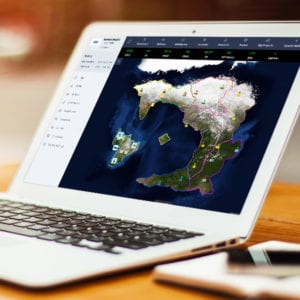
Save Time
The simulation is easy to set up and runs itself. You have a new tool to draw connections to course concepts and spark dynamic conversations. All-unique simulation scenarios every semester promote academic honesty. Instructor tools do tasks like grading for you.

Creates Network Connection, Contextualizes Lessons, & Connects Decisions to Outcomes
Statecraft is incredibly valuable long-term in establishing the utility of the class, establishing the classroom environment and making sure that the important lessons of IR almost become real for the student.
use statecraft 100% ONLINE OR IN-PERSON

Easily create an unforgettable, dynamic online class
- Fully-automated: Once launched, the system prompts students and moves them through the simulation without any instructor action required
- Online chat & online messaging systems: to allow full class communication, student-to-student messaging and team collaboration all within the product interface
- 24/7 live asynchronous design: students can play whenever they want on their schedule without needing to coordinate class time
- Customer Support: available 7 days a week and ready to answer any and all online class questions!
This is a great choice for you if you’ve recently moved a class online and need an easy, effective way to spark student interest, create engagement and foster participation. It’s also a great choice if you’re unsure of what your class format will be next semester: these simulations will easily transition with you whether your class is 100% online, in-person or a blend.
Introduction to Political Science SImulation for Understanding the Political World.
The Statecraft World Map is where all of the action happens! Students can log in via a desktop computer or a mobile device. The map illustrates the geographical layout of the world showing resource centers, deserts and mountains as well as the climate situation. The colored lines delineate territory zones belonging to each country. The icons mark cities, military units, landmarks and terrorist occupations. Once a student spies on a foreign country those cities and military units will also be exposed. Clicking on the icons reveals more information and there’s a detailed legend key to offer extra map guidance.
In the nav bars at the top students can access all of the critical information for their world as well as look at their intelligence data for other countries. They’ll be able to access their Diplomacy, Military, Intelligence, Domestic and Research activities as well as manage their Resources.
Diplomacy
- Build International Organizations
- Collaborate to solve global issues like climate change, world hunger, terrorism, and human rights
- Construct Treaties
- Exchange Ambassadors
Military
- Enhance military technological capabilities
- Strategically build their national defense strategy
- Build and maintain a navy, air force, and army
- Forge collective security alliances
Intelligence
- Spy on other countries' domestic politics, economy, and military capabilities
- Build counter-intelligence capabilities to limit spying in their own country
- Run covert operations to sabotage and undermine other countries
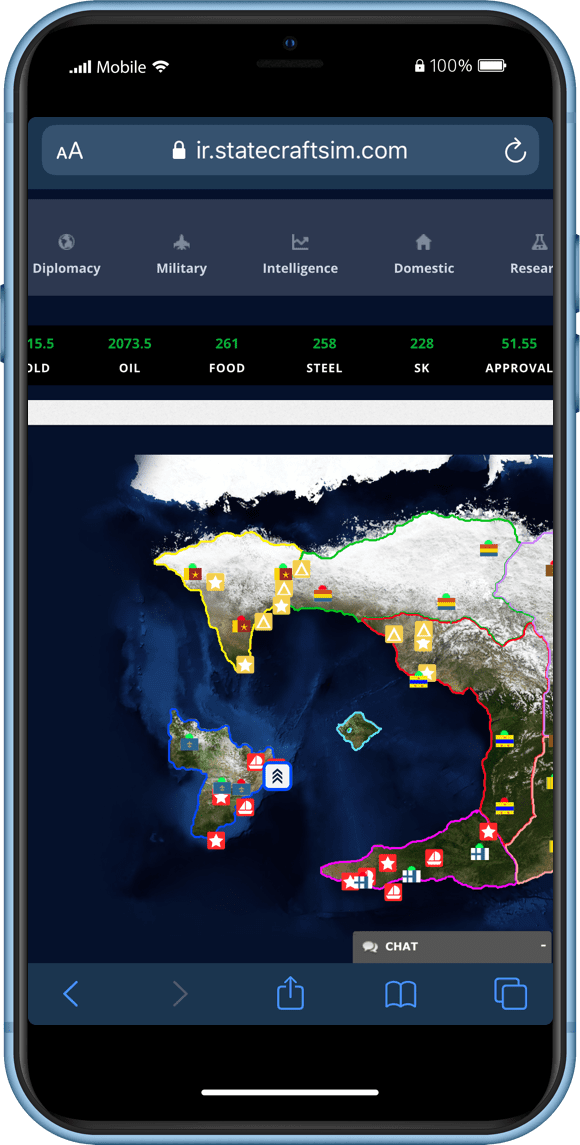
Domestic
- Enhance your Citizens' Healthcare and Unemployment System
- Improve your Justice System and Environment
- Invest in Public Education and University Systems
- Foster your country’s unique culture and gain tourism points!
Research
- Gain new, powerful technologies that can enhance domestic ratings such as health, safety, the environment, or improve national security
- Trade technologies with other countries to more rapidly develop their Quality of Life and National security
Resources Bar
- Manage economic resources
- Budget for enhancing domestic infrastructure or security
- Trade with other countries and develop relationships with countries that produce needed resources
Time-Saving Instructor Tools for Introduction to Political Science.
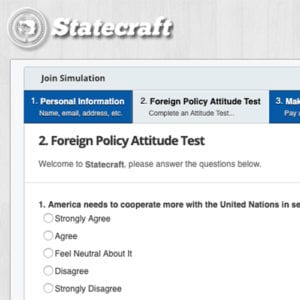
Student Assignments
Statecraft automatically assigns students to roles based on a brief attitude test designed for optimum role fit and student collaboration during the initial signup process.

Automated Student Prompting, Feedback & Calculations
Professors report an average of 13% time savings by using simulation tools that automatically prompt students, issue feedback, and guide outcomes.
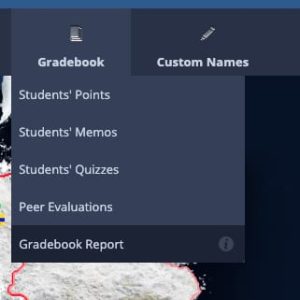
Automated Grading
The Statecraft system tracks all choices and outcomes and automatically reports final grades to the instructor in an excel exportable format for your convenience.
"ALLOWED THEM TO APPLY THE CONCEPTS"
I used Statecraft in my large (150 person) Introduction to International Relations, and the simulation was a great hit with my students. It allowed them to apply the concepts that we were learning in class to their on-line Statecraft world and to grapple with the difficult decisions foreign policy leaders face on a daily basis. Students came away from the experience not only with an enriched understanding of international conflict and cooperation, but also with a better grasp of the nexus between domestic and international politics. More than anything, participating in Statecraft made students think critically about their own prior beliefs about international politics. It was also fun! The students got to meet one-another (a daunting task in a room of 149 other first year students), and I frequently spotted students playing Statecraft all around campus. I’m looking forward to using Statecraft again!
"EXTREMELY HELPFUL TEACHING TOOL"
I used Statecraft in my introductory International Relations course, and it was a big hit among my 150 students. Statecraft is an extremely helpful teaching tool that helps to engage students who have different ways of learning, and brings a fun element into the classroom. Not only did they get to experience IR from an entirely new perspective, they also got to know each other really well and develop a sense of camaraderie. Their Statecraft country groups turned into study groups and helped them to get more involved in the course in general. I highly recommend Statecraft!
"A VERY USEFUL ACTIVE LEARNING TOOL"
I use Statecraft whenever I teach the Introduction to International Relations course. Statecraft has been a great teaching tool to reiterate important concepts from the text that makes the learning experience enjoyable for students. It enables greater interaction in the classroom and generates interesting debates on competing domestic and foreign policy goals. Students come away with a better understanding of the complexities and challenges of policy making. It is a very useful active learning tool that students can benefit from tremendously.
how Statecraft Introduction to Political Science works for understanding the political world
Easy Set-up & Launch
- Easily adaptable for small classes under 20 students or for large classes up to 600 students running multiple worlds; each world will have six to 108 students
- Run through an easy 3-minute configuration and get the code for students to activate their simulation
- When students sign up with the code they’ll pay for the simulations
- The Political Role Attitude Survey automatically groups like-minded students together into roles and countries when they sign up, ensuring variation in countries’ views and policy approaches
- You set the start date plus the number and duration of the “turns”; commonly teachers launch the simulation in the third week of the semester and run it for seven to 10 turns/weeks, however you have complete control to set the optimal timing based on your class needs and schedule
- There will be six to 12 countries in each world with up to nine roles per country
- Students receive a comprehensive instruction manual and their first quiz asks key questions from the manual to make sure they understand how to play
- During the preparatory “Turn Zero” students configure their country and personal roles
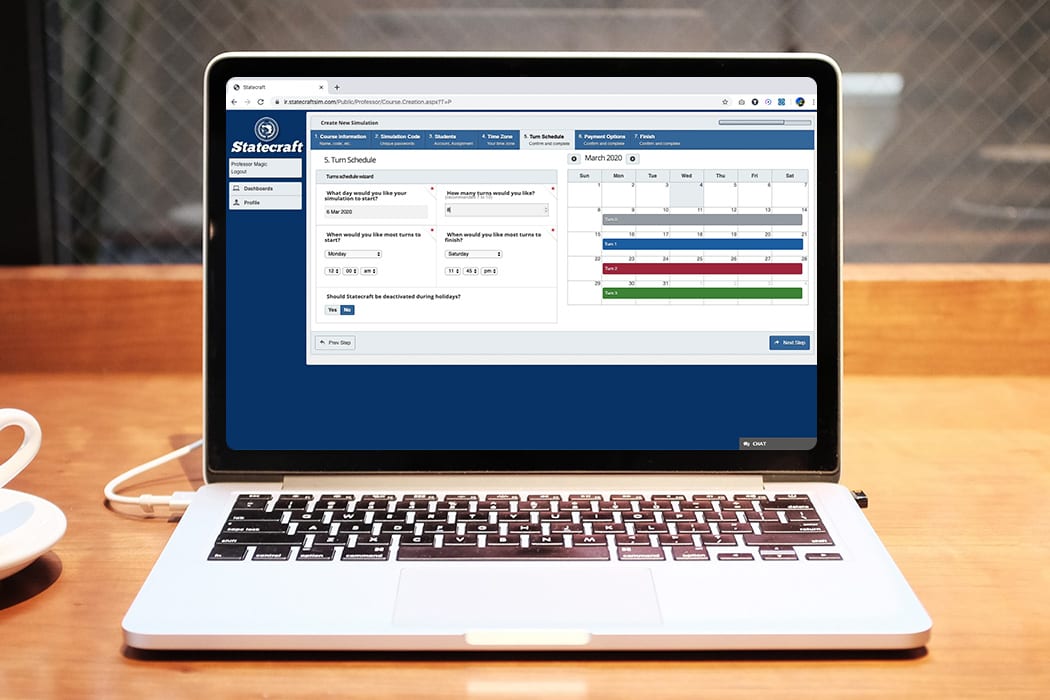
An immersive Introduction to political Science Simulation for understanding the political world.
Once the simulation launches, students meet as a country and their first action is to choose a country name, city names, and positions for each student. They also select a government type and two attributes which will bestow special country abilities and constraints. Students’ initial decisions about their country type and attributes are the foundation for their strategy and affect the way they’ll be able to operate in the simulation.
Every regime type has bonuses and drawbacks. For example, in a democratic regime the country’s embrace of freedom yields educational and scientific benefits and makes the population happier. The downside is increased crime, a coarser culture, and limits to rapid military mobilization.
Regime type and country attributes factor into the country’s Quality of Life scores each turn, which significantly impacts points earned. That means dedicating resources to building up the country’s health, welfare, education, and other domestic ratings is a critical part of overall success in the simulation. Leaders must keep their people happy and healthy!
Student Positions
- President
- Secretary of State
- UN Representative
- Secretary of Defense
- Director of National Intelligence (DNI)
- Director of Science and Industry
- Trade Representative
- Chief Political Strategist
- Domestic Affairs Adviser
Regime types
- Democracy
- Constitutional Monarchy
- Communist Totalitarian
- Military Dictatorship
Screenshot showing the constraints when students choose the “Constitutional Monarchy” regime:
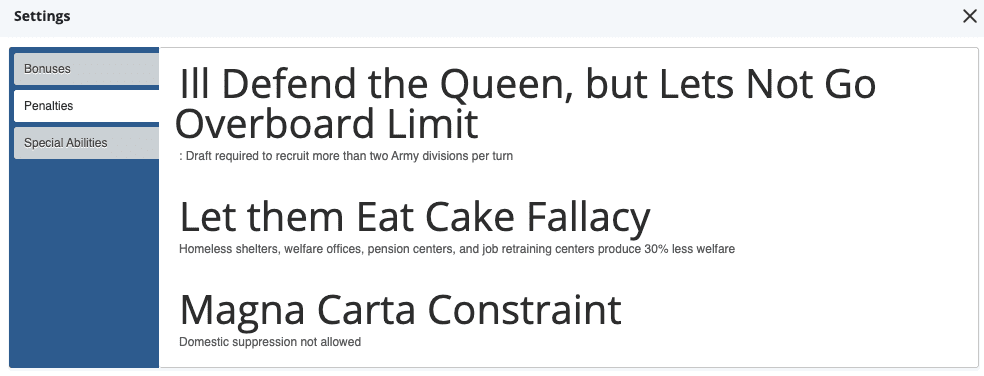
Country attributes
- Industrial
- Green
- Militaristic
- Pacifist
- Scientific
Screenshot of “Scientific” attribute bonuses:
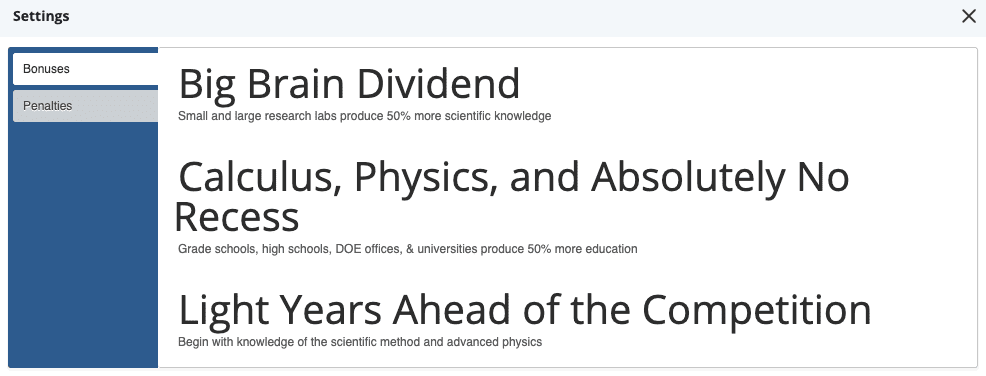

Playing the Introduction To Political Science Simulation for Understanding the Political World
- Students are playing to earn points by achieving both the world collective goals and their individual country goals
- Everything is prompted by the system; it tallies points for performance and participation and calculates grades for you at the end of the simulation
- The simulation runs live 24-7 so students can play anytime without you needing to schedule class time or a computer lab
- At the end of each turn the decisions or “moves” students made during the turn actually happen and they can see the results of their actions
- Every turn each country produces resources that can be used to buy military units and domestic structures, trade with other countries, research technology and invest in big projects like Alcatraz or the Louvre
- Students also make strategic decisions such as drafting treaties, forming alliances, engaging in espionage or launching a military attack
- Global issues such as terrorism and climate change will affect all of the countries in the world, requiring collaboration to resolve
The Instructor's Role
- Watch as the students collaborate and compete with one another to be successful and gain the most points
- Act as an executive consultant to help guide students and answer questions about how real-world countries deal with similar challenges through diplomacy, international organizations, economic statecraft, and military action
- Statecraft help desk will assist students with any technical questions or troubleshooting
- Use the simulation events as learning opportunities to draw correlations to course concepts
- See all of the events happening in the simulation by looking at the global map and tracking tools
- Offer students 30+ minutes of class time to meet in their country groups each week to decide on big world moves (recommended but not required)
- If needed you can use a master account to make “godlike” decisions should there be world crisis; as the instructor you always have ultimate control over your simulation world

Reality: challenges, opportunities, and tradeoffs
Students start out with aspirational goals and a strategy to achieve greatness, yet reality quickly demonstrates great plans are difficult to achieve! They must grapple with a complex mix of domestic and international factors as they experience first-hand how maddeningly complicated global politics truly is. They’re presented with conundrums such as guns vs. butter. Suddenly there’s a mountain melting that could flood the world, terrorists are attacking and their population is rioting because of famine – ACK!
This “controlled chaos” affects students on a personal level: they’ll experience real emotions like excitement, frustration and shock! You’ll find a wealth of teachable moments and students will be asking you intelligent questions as they try to figure out what to do. Working through these issues is how real learning happens and it’s the reason the Statecraft IR Simulation is so effective.
Many Possible Strategies,
Including:
- Wealth-building strategy
- Empire-building approach
- Diplomacy seeking world peace
- Isolationist maximizing quality of life
- Militaristic domination by force
National Decisions Required Concerning:
- Resource Scarcity & Trade
- Domestic Political Factions and Their Demands
- Investment in “Guns” vs. “Butter”
- Immigration and Refugees
Global Issues that Cannot be Ignored:
- International Organizations and Treaties
- Impacts of Climate Change
- Espionage and Terrorism
- Cybersecurity
- Nuclear Proliferation and the Military Balance
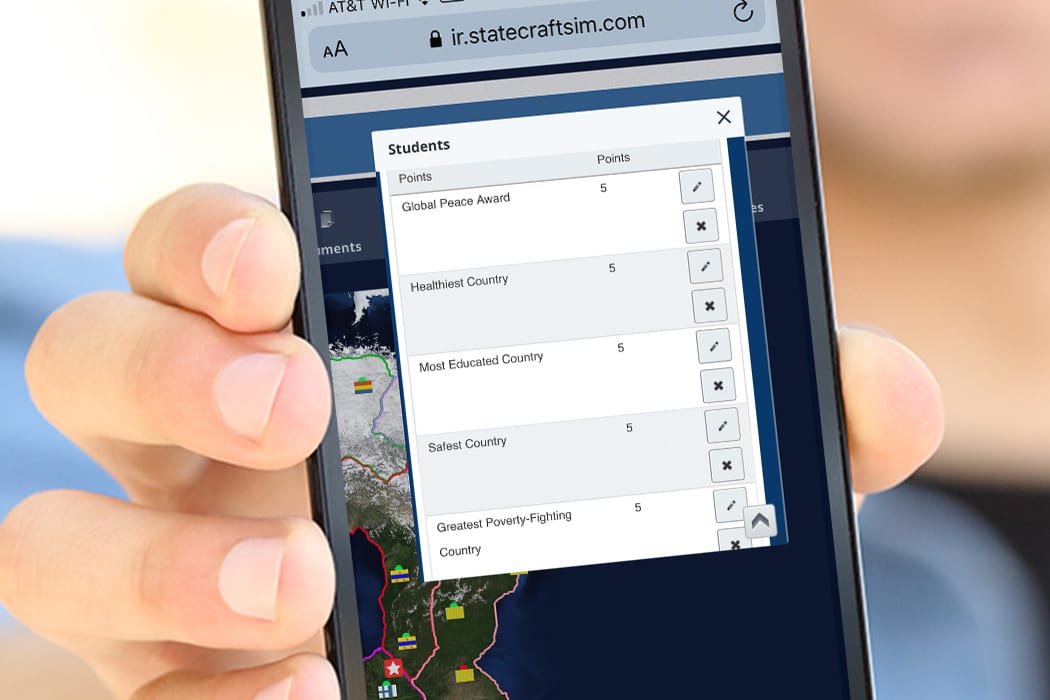
Conclusion & Grading
- When the last turn ends global goal points are given, individual country points are tallied, awards are bestowed and grades are issued
- The system provides a gradebook showing students’ final point totals in a table that is easily exportable to Excel
- Statecraft also offers suggested assignments (quiz/exam questions, paper topics, and discussion questions) that can count toward students’ course grades
- We recommend a final debrief in which countries present their version of “what happened” so the class and the instructor have insight into all perspectives
- Students can still receive a good grade for participating fully in the simulation even if their country and world collapse due to poor choices (but instructors can modify grades based on apparent effort)
- There are unlimited outcomes possible for the simulation! Every run of the Statecraft IR Simulation result is unique
- Since every class experience is unique, it is difficult for students to “cheat” by relying on outside help or past students’ experiences; In this way, the simulation encourages academic honesty and makes assessments easier for you
If you’re looking for even more detailed information, see the Resources page for the instructor manual, sample syllabus and other helpful documentation.
"STUDENTS ARE BUILDING VALUABLE SKILL SETS"
I have been using Statecraft in my Introduction to International Relations course for five years, and each semester is different! The benefits, however, are consistent. For the instructor, using Statecraft establishes the classroom as an interactive experience from the beginning, which spills over into class periods where we are discussing course content. The students are building valuable skill sets that they transfer to other academic and professional settings, particularly related to working within groups and negotiation tactics. And no matter what paths students take in navigating their way through the game, they will utilize and apply concepts in international relations. It’s not just that students are learning the course content, they are experiencing how challenging it can be where there are multiple things coming at you at all times that must be dealt with. This provides context for a better understanding of the decision-making process in current events.
"STUDENTS APPLY ABSTRACT CONCEPTS IN A FUN WAY"
Statecraft is an engaging educational tool that I used in my Introduction to International Relations course. Through Statecraft, students were able to apply otherwise abstract theoretical concepts in a fun way and it helped them understand theories’ relevance in the ‘real world’. Not only has Statecraft broadened students' understanding of international relations, it has also given me multiple opportunities to relate theories to students' actions in the simulation. This made lectures more engaging and concepts easier to explain. I chose to read and grade all memos and give students extensive feedback, which is optional, but other than that Statecraft basically ran itself and left me with lots of time to prepare lectures. I added several in-class ‘Statecraft Summits’ to give the different countries a platform to negotiate in person, feel tensions and come to agreements with multiple countries. Students wrote Reflection papers after the simulation ended and I was pleased to see that students indeed very much enjoyed the simulation and that it also challenged them intellectually and improved their interpersonal skills. I most certainly will use Statecraft again in the future.
"AN EXCELLENT LEARNING RESOURCE"
I have used the Statecraft International Relations simulation in five of my IR classes in the past year and a half, and my experience has been overwhelmingly positive. Statecraft encourages students to work together and cooperate, just as the professional and political world requires them to do. Moreover, Statecraft is another valuable tool that can help bring the concepts and ideas discussed in our lectures to life. It is a well-known fact that students learn best by applying their knowledge, and Statecraft, with all the dynamism and appeal of a video game, allows learners to do just that. However, Statecraft is more than just a game, and indeed students often take their participation in the simulation very seriously. Just like real-world politics, passion and competition often result in some surprising and unpredictable situations – alliances, betrayals, rescues and invasions, even full-blown wars! Students have always reported that they enjoy the simulation, and that it really makes them think about international relations in a practical way. Statecraft is an excellent learning resource for the 21st century classroom, and I wholeheartedly recommend it.
Let's do this! Experience Statecraft for Yourself
Book your personal demo today! We’ll answer your questions, show you how these cool features work and help you set up your first Statecraft IR Simulation.
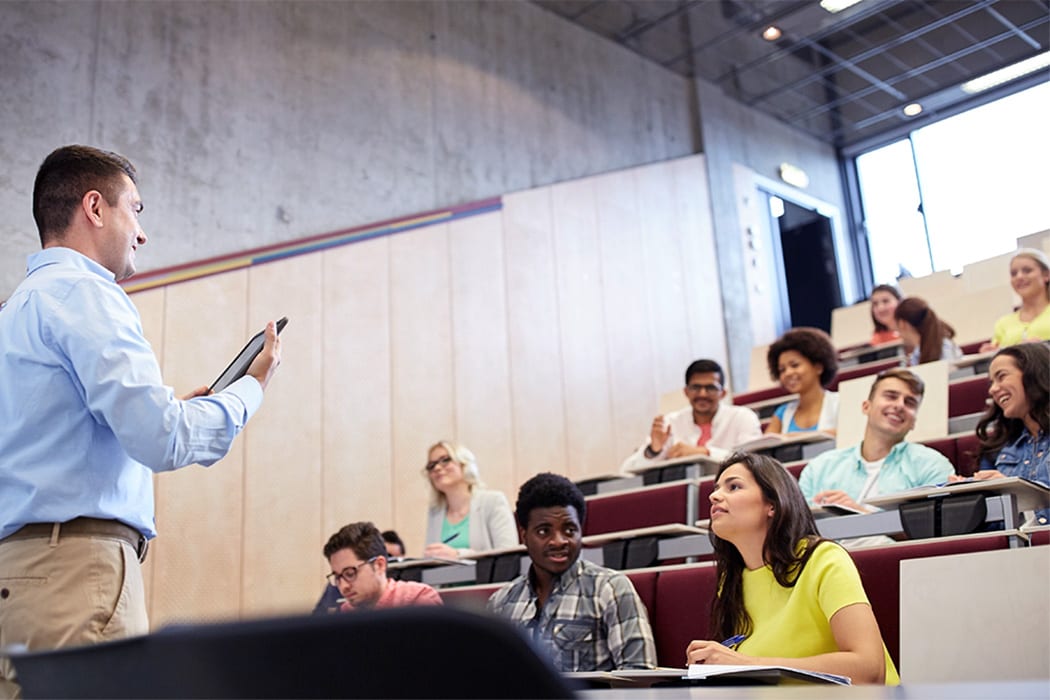
Results you’ll experience:
- Heightened student engagement & greater attendance
- Quality student questions and requests for strategy consultation
- Students are able to discuss course concepts intelligently and develop strong opinions that spark interesting class conversations
- More camaraderie among the students, social connections, sense of community
- Students will form study groups and you’ll hear students speaking about topics such as enforcing UN resolutions or the security dilemma outside the classroom
- Statecraft Simulations promote academic honesty: since every simulation experience is completely unique it’s practically impossible for students to cheat
- Your class popularity will increase due to previous student recommendations
Costs much less than a textbook
Students pay
$39.75
- One-time payment per student per semester
- You assign the simulation to students, give them the activation code and they purchase it just like they would purchase a textbook
- Statecraft cares deeply about facilitating student learning so we keep pricing as accessible as possible
4.72
out of 5 stars
Instructors rated Statecraft Customer Service 4.72 of 5 stars User Satisfaction Surveys
Excellent Customer Support
- You have help at every step of the process: from set-up to implementation with quick assistance for any questions you have along the way
- Both you and students can reach out to us directly at any time
- Our customer support is available 7-days a week from 7am to 11pm; we try to answer fast and always get back to you within 24 hours
- We’ll take care of students' technical questions so that you just handle the political questions
- Teachers who reach out and ask questions report some of the best overall simulation class experiences, so we highly encourage you to contact us!
"STUDENTS BENEFIT GREATLY FROM PLAYING"
Statecraft allows students to experience first-hand the complex mix of international and domestic pressures that states face in the international system. I've seen my students benefit greatly from playing the game, as they emerge with a much more sophisticated understanding of course concepts. It's one of the best simulations I've found.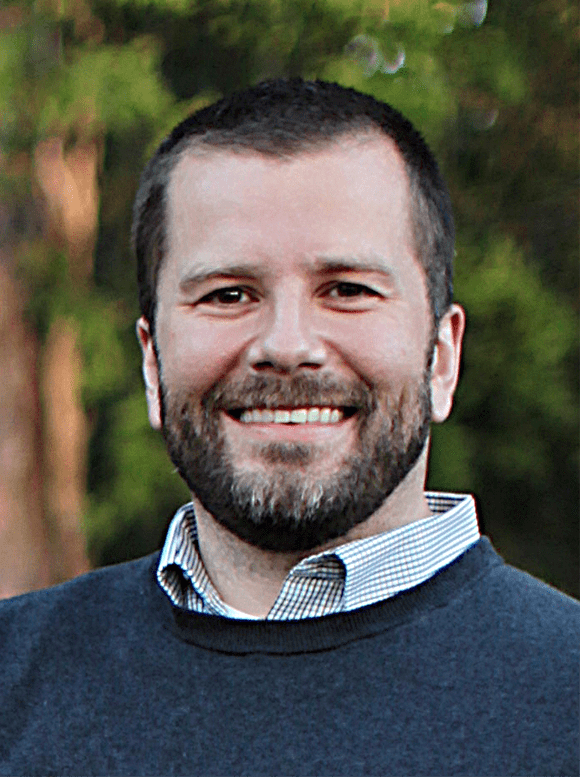
"A REMARKABLY RICH SIMULATION"
Statecraft accomplishes the difficult feat of simultaneously engaging student interest and exemplifying important principles of international relations theory. It provides a remarkably rich simulation of world politics that practically runs itself with no need for time-consuming instructor intervention, while still allowing teachers of more specialized courses ample opportunity for customization. I recommend Statecraft without reservation to all instructors of undergraduate international relations.
"GOOD BALANCE OF PLAYABILITY + MULTI-DIMENSIONALITY"
Statecraft is a good simulation for undergraduate courses in International Relations where you want to explore the connections between domestic and international affairs. It offers a good balance of playability + multi-dimensionality. It’s not just about diplomacy; it’s about balancing internal and external factors that feed into your capabilities.
Get started today to experience how Statecraft brings Introduction to Political Science to life in your course!
You can sign up online now to get started immediately or book your personal demo! We’ll give you a complete product tour, answer all of your questions and help you configure your first Statecraft IR Simulation.
Statecraft Simulations are used in 15 countries at over 475 universities
Statecraft Project LeaderMaker
As a company, we are passionate about student success! Our mission is to engage students in social science topics in a way that ignites their curiosity, excitement for learning, and social skills regardless of their learning styles or socio-economic disadvantages. In the spirit of this mission, we founded the Statecraft Project LeaderMaker, which donates simulation accounts to low-income high schools.
How it works:
- Colleges use Statecraft Simulations in social science classes
- Statecraft donates simulation accounts to low income high schools
- At-risk students are reengaged in school and gain employability skills
- More students graduate high school with leadership and employment skills
The number of accounts donated is determined by evaluating school’s free lunch percentage and unique budget constraints. Contact Joe at [email protected] to learn more about the program.

Let's Keep In Touch
Sign up for the Statecraft Newsletter and we’ll send you product updates, simulation tips and exclusive offers straight to your inbox!
